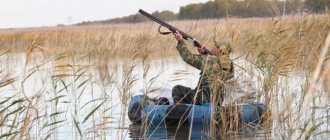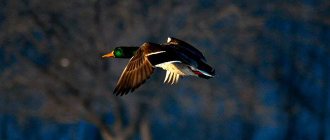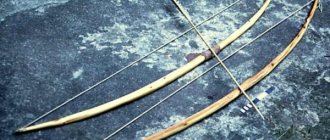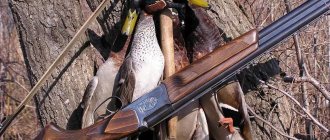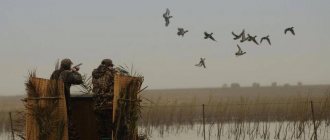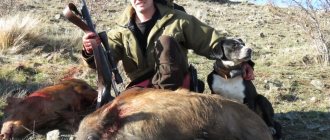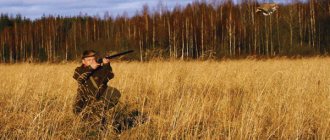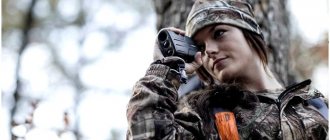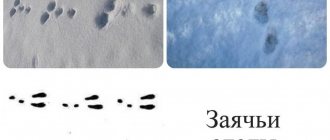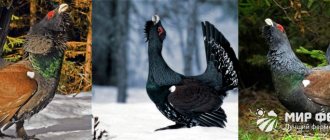Duck hunting is one of the simplest and most affordable ways for most hunters to shoot a bird. But shooting at a flying duck requires certain skills, abilities and habits.
Why they prefer to hit ducks in flight, the reason is simple - sitting on the water, firstly, it is a smaller target, and secondly, its weak areas are covered with dense wing feathers. Therefore, shooting at swimming ducks is not very effective and often leads to the appearance of wounded birds.
A little about weapons and ammunition
First, let's figure out what is the right thing to go hunting with, what gun, shot and cartridge to choose. During such a hunt you have to shoot a lot and often, so it is better to use self-loading shotguns or double-barreled shotguns with an ejector, but ultimately, the choice of a shotgun is a matter of taste.
The choice of barrel should be correlated with the distance at which you are going to hit the duck. The smaller the narrowing, the greater the spread of shot and the likelihood of shooting a bird, but already at a distance of more than 40 meters with a cylindrical barrel, the spread of shot will be excessive.
Read more about what kind of shot to shoot a duck with a gun.
The same applies to shot, the larger its diameter, the greater the distance it will hit the bird, but at the same time the probability of a hit decreases by the same amount. Fraction No. 5 will be universal for duck. Shots No. 7 and No. 6 are better at short distances, and over 50 meters it is better to shoot No. 3 or No. 4. The same applies to the size of the prey. So for teal, the optimal shot would be No. 7, and for mallard it is advisable to shoot with No. 5.
It is better to select a cartridge with a sharp strike, choosing the right wads for this. The spread of the shot will depend on the container, which is also important.
Shooting a flying duck
As with a swimming duck, you need to shoot a flying duck from the front, but at the same time make a larger margin in the angle of the shot - the flight speed is higher. Autumn hunting begins at the end of summer, when all the young ducks begin to fly. The young animals are still in the grass and thickets, so hunters in boats approach them. At night, ducks migrate in flocks, and then the hunt begins.
At this time or at the beginning of autumn, the birds gather in groups and rise on the wing, flying away to wintering in other regions. Hunters use various stuffed animals and decoy ducks to lure them. To catch prey on the fly, the hunter determines the path where the bird often flies en masse, at a low altitude. In the evening, the hunter stands under a tree and waits in silence so as not to scare away the prey. They usually shoot in the evening or early morning, when the duck sees poorly and allows the shooting distance to be reduced as much as possible.
Cloudy weather is very good for hunting, because then the ducks fly low and allow them to come closer. Hunting during the day consists of the hunter looking for places where birds are located and watching their flights. In the evening, he goes around in a boat around the supposed place where the ducks are sitting. Their position can be determined, for example, by their feathers.
They make a shelter in the place where there is the largest concentration of ducks, and wait for the bird to fly to the pond. The shelter should not be small, the height of a person, because you may need to shoot while standing. The shelter should be positioned so that the sun does not shine in your eyes. They go on such a hunt very early in the morning, even before sunrise - at this time the ducks are calm and easy to take by surprise.
A little theory
Before indicating leads (removals) for each of the distances and situations, let's consider the general theory of why they are needed at all. From the moment the shot hits the primer until the shot travels a distance of about 30 meters, about 0.1 seconds pass, during which time the flying duck moves by 1 - 1.5 meters. If you shoot at the bird itself, then even with the most correct placement and shot, the shot spot will fly behind it.
Therefore, you need to shoot with anticipation, not at the duck itself, but at the place where it will be in a split second, at the moment when the shot reaches there. To do this, during aiming, the barrel is taken out - shifted slightly forward, in the direction of movement of the bird.
Calculates leads
If a beginner is trying his hand at hunting, then he needs to figure out how to calculate the lead when shooting at a duck and other flying birds. The calculation is simple: the flight speed is multiplied by the speed of the shot. However, this does not mean that you will dream of calculating these indicators during a hunt. You need to keep this data in your head and make decisions quickly. The data from the table will help for the calculation.
| Bird species | Flight speed, m/s |
| Capercaillie and black grouse | 15–18 |
| Teal | 18–35 |
| Duck | 21–27 |
| Mallard | 18–27 |
| Partridge | 13–14 |
The necessary data for calculating the lead is also considered to be the flight speed of the shot; depending on the distance to the duck, the speed changes.
| Fraction number | Speed fractions m/s in depending on distance to target | |||
| 20 m | 30 m | 40 m | 50 m | |
| №1 | 0,06 | 0,10 | 0,14 | 0,18 |
| №3 | 0,06 | 0,10 | 0,14 | 0,19 |
| №5 | 0,06 | 0,10 | 0,15 | 0,20 |
| №7 | 0,07 | 0,11 | 0,16 | 0,22 |
| №9 | 0,07 | 0,11 | 0,17 | 0,24 |
Using these data, calculating the lead when shooting at a duck is quite simple, just remember that the speed of a frightened game may differ from the standard flight.
Optimal lead
So, let's move on to the leads, but before indicating specific values, it should be noted that this will be their average, approximate value. Each person has his own physiology, his own speed of reaction and functioning of the nervous system, eye, and motor skills. In addition, each gun and cartridge will have its own delays, yes in miles and even in microseconds, but they will also affect the overall lead.
Therefore, taking into account the techniques and leads described below, in order to aim correctly and accurately hit a duck, you must practice them yourself, with your own gun and for a specific cartridge. So below, we indicate the average offset values for various conditions.
Distance 20 meters
If the duck flies horizontally, at a distance of about 20 meters, perpendicular to you or at an angle, the lead is made one body in front of it, in the direction of its movement.
Distance 25-35 meters
Under the same conditions, at a distance of 25 - 35 meters, the take-off should be made by two lengths, in the direction of its flight.
Learn how to hunt ducks using decoys.
Distance 40-45 meters
When the distance to the duck is 40 - 45 meters, the lead should be taken three to five lengths in front of it. Here the cartridge and the gun will already have an influence, so takeaways at such distances need to be worked out first.
Upon landing
When a duck lands near you, for example, near decoys, you need to aim just below the head or directly at the head, depending on the distance.
Stealing duck
When shooting at a stolen bird flying away from you, you need to aim below it (in front of it in the direction of its movement) so that there is a gap between the muzzle of the gun and the silhouette of the bird.
We select the amount of clearance depending on the flight altitude, according to the first three points.
By oncoming bird
Aim at the duck that will fly at you so that the barrel covers it, and the end of the barrel is one or two body heights higher than its silhouette. This is one of the most difficult methods of shooting, so the bird is often passed above you and shot after it.
On takeoff
Shooting at a taking off duck is carried out above it, that is, you need to shoot with the trunks covering the silhouette of the bird and slightly above it. The takeaway will again depend on the distance.
Shooting a sitting duck
- If you hunt a swimming duck, then you need to aim at the bird (in the middle of the line formed between the carcass and the surface of the water).
- Shoot in the middle, directly at the bird, if you see that the duck is not moving.
The most protected place in a duck is the chest, because there is a dense feather barrier on it. Therefore, when hunting, it is recommended to shoot in the back or side of the bird. If the duck is flying, then you need to shoot ahead of the bird so that the charge hits the carcass. After all, it takes some more time for the charge to reach the target, and at this time the bird moves forward. In the same way, you need to calculate the trajectory of movement when a duck swims quickly.
The hunter must constantly calculate the distance between the barrel and the target. In order for the charge to hit the bird, when shooting close, it is recommended to aim at the head, but at a great distance the shot already scatters significantly. An experienced hunter, looking at a flying target, will immediately make approximate calculations and be able to accurately hit the duck. This allows you to concentrate, choose the right shooting angle and make one accurate shot.
Leash technique
Well, we need to remind you how to properly shoot at a flying duck, or at any fast-moving target.
- when aiming, they begin to move the barrel as if after the prey, aim at it, accompany it, and then make the necessary extension of the barrel, while pulling the trigger. The movement should be smooth, with uniform acceleration.
- The leash is made by turning the entire body.
- The trigger is pressed smoothly using the front phalanx of one finger.
- When firing, the barrel should not be stopped under any circumstances; it should not freeze for a moment.
As experienced hunters say, with a smooth release of the hook and a leash with the barrel, the shot should be unexpected for you, this is how you will avoid the reflexive freezing of the gun when firing.
Familiarize yourself with the peculiarities of duck hunting in the fall.
It is not true that it will take more than one year to develop correct shooting at a duck. Aiming and shooting at moving objects can be easily practiced by shooting at clay pigeons. But you need to do this with the gun and cartridges with which you will then go hunting.
Shooting technique
Shooting at a moving target requires knowledge of how to aim a gun and more careful preparation of the shooter. Shot shooting at a flying duck is carried out with a stationary gun or with a leash.
Shooting with a stationary gun
Such shooting is characterized by the fact that the gun is directed to a point located in front of the target, along its line of travel. When the target approaches the calculated distance to the aiming point, the trigger is released.
Shooting with a leash
Are you hunting duck? Then you need to know how to shoot a duck in years. From the moment the decision is made to fire until the shot itself, when the shot leaves the muzzle, 0.024 seconds pass. During this time the duck manages to cover 48 cm.
Accordingly, the charge passes by if you take the aim clearly at the bird. To avoid this, use a leash. That is, the gun does not stop at the moment of firing, but continues to move behind the target.
The trigger is pressed smoothly, without jerking and without stopping the weapon. To this must be added the correct calculation, called lead when shooting at a duck, depending on the shot number and target range, as well as the speed and direction of its flight.
There are certain rules on how to shoot ducks correctly:
- A swooping duck forces you to speed up the lead and shorten the lead.
- A duck passing sideways at a distance of up to 40 meters significantly slows down the leash, and you have to use large leads, up to 1.5 meters. In this case, the gun may stop, so it would be more effective to use a method called shooting while overtaking, starting the leash behind the bird, and, having overtaken it by the required distance, fire a shot.
- Game coming at a bayonet point at a low altitude requires a slow lead, and if it suddenly moves above the hunter, then the shot is fired at the moment the prey is blocked by the trunks. When flying low, it would be better to release the duck forward and shoot at the hijack.
One indisputable rule for the shooter should be: no matter in which direction the gun barrels have to be moved, this movement is made only by the body, and not by the hands.
The single arm-body-gun system remains motionless, the direction changes only with the help of the torso. The hunter must stand half a turn towards the intended point at which the ducks will be shot.
How to shoot a duck and hare correctly
Continuation. Start in the materials “How to learn to shoot”, “How to shoot correctly”, “How to learn to shoot accurately”, “How to learn to shoot while moving”. Follow the links.
How not to miss the game
In most cases, when a hunter misses a running hare or a flying duck, he makes two serious mistakes. The first is that the lead is incorrectly selected for a given moving target. The second - does not accompany the target with the barrel of the gun before the shot, maintaining the lead taken. At the same time, when firing, he often closes the eye with which he is aiming. It is clear that the percentage of hits in game will be, to put it mildly, small. The correct way to shoot a duck is to shoot a hare differently. Having seen the game, you need to raise the gun (with an adjusted sight) in front of the target, set the necessary lead, start moving the barrel along the line of movement of the object, and only then, without stopping, pull the trigger. What lead to take when shooting at a flying duck or a running hare is described in other articles (go to articles via links). Here we will analyze the practice of rifle wiring. The best option is to practice at the flying saucer shooting range under the guidance of an instructor. But not everyone has the necessary time, and these activities are expensive. Another option is self-training. For this you will need a responsible partner. It is best to use a plastic water bottle as a target (it does not produce fragments, unlike a glass one). Moreover, if you throw first an empty bottle, then a little filled with water, then a full bottle, then its flight speed will be different accordingly, i.e. you will have to take different leads and change the speed of the barrel (exactly what we need). The essence of the training is that your partner, leaving the shooting line (!) and standing in front of you, 10 to 20 meters away from the side, throws a plastic bottle up and to the side in front of you. The shooter, standing at the ready (gun level, aim adjusted), must hit it with one shot.
How to shoot game correctly
I dare to assure you that if you make mistakes in aiming, moving the barrel and rushing to fire, you will not hit the bottle. Try to shoot correctly right away: aim, move the barrel and shoot. Each shot should be approached collectedly and very seriously. When you hit several times in a row, it means you have developed a solid skill for the correct shot. Proceed to shooting at the tossed empty cartridge case. Having learned to accurately shoot at thrown objects (a plastic bottle, an empty metal cartridge), you will correctly shoot a duck, a hare, and you will not miss other flying, running game. To be continued. How to compensate for recoil.
